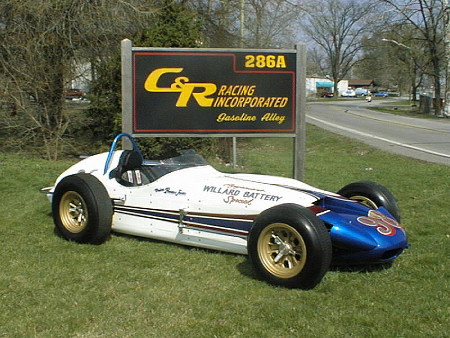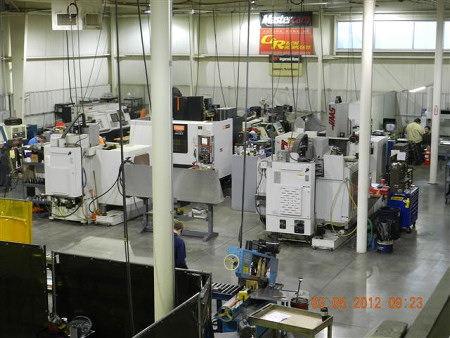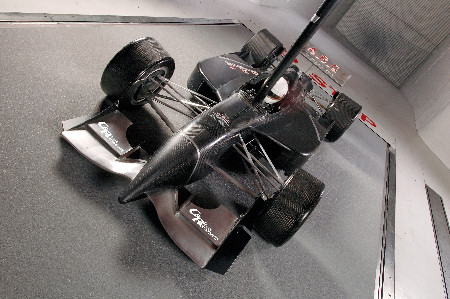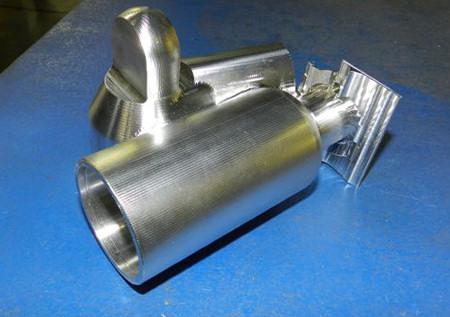The Way It Is/ Racing's go-to guysby Gordon Kirby |
 C&R Racing is based on Guion Road in northwestern Indianapolis in the heart of the city's racing industry. Owned and operated by Chris Paulsen, C&R is one of America's most renowned fabrication shops building all kinds of race car components. For many years C&R focused on building machined and fabricated pieces for the Indy car industry but these days most of C&R's business comes from NASCAR. C&R supplies water and oil radiators to most of the field in NASCAR's Sprint Cup, Nationwide and Truck series and also builds NASCAR transmissions.
C&R Racing is based on Guion Road in northwestern Indianapolis in the heart of the city's racing industry. Owned and operated by Chris Paulsen, C&R is one of America's most renowned fabrication shops building all kinds of race car components. For many years C&R focused on building machined and fabricated pieces for the Indy car industry but these days most of C&R's business comes from NASCAR. C&R supplies water and oil radiators to most of the field in NASCAR's Sprint Cup, Nationwide and Truck series and also builds NASCAR transmissions.
A quarter of a century ago Paulsen made his mark as a top Indy car crewman, working for Johnny Capels' team for a few years and preparing other cars for the Indy 500. He also raced sprint cars and founded C&R in December, 1988 with Ross Fisher, a successful Goodyear tire distributor who once owed a sprint car Paulsen raced. "Ross invested $30,000 and I put in $30,000," Paulsen recalls. "I had all the equipment and that's how we got started. Five or six years after we started the business I bought Ross out and we're still great friends." Today, C&R employs almost seventy people, including many of the racing's industry's most skilled and experienced old-timers.  © C&R Racing "The way I describe C&R Racing is it's a job shop for professional racing. We're the go-to guy for almost anything a race team needs. I put the quality of our fabrication up against anybody in the business." Paulsen also helps organize the International Motor Sports Industry Show at the Indiana Convention Center in December in partnership with NASCAR champion Tony Stewart and USAC heavyweights Jeff Stoops and Tom Weisenbach. The IMIS show has been going for four years and includes a Safety and Technical Conference sponsored by Safety-Kleen and organized by former CART technical director Kirk Russell. These days Paulsen and C&R have been frozen out of the Indy car business and Chris finds himself a reluctant but enthusiastic supporter of NASCAR. He would love to get back into the Indy car business but sees little opportunity under the current rules package. "In IndyCar up 'til this year we were noted for building really nice, high quality suspension components for oval tracks," Paulsen said. "Dallara built all the road course stuff but it was open to others to build the oval suspension pieces and we did a lot of that. We also machined all Penske's brake hats and we had all the IndyCar brake business up 'til this year. But Dallara has given that to Brembo. "Five or six years ago we built all the front wing molds for McLaren," Paulsen continues. "As you know, their front wings are really beautiful and very complex, so it was a pleasure to do that job. Typically, McLaren don't farm work out, but we're really good at three dimensional surfacing and when they get overloaded, which happens sometimes, they ask us to help. We've been a go-to shop for a few Formula One teams. Back in the BAR days we did a tremendous amount of work for them." One component Paulsen loves to work with are shock absorbers. "We build the shocks for Joe Gibbs' moto-cross team. We work with my friend Jeff Ryan at JRI. These are some really wild west pieces, much crazier than anything you'll see in NASCAR or IndyCar.  © C&R Racing Paulsen hopes to dabble in some Indy car shock development this year. "The shocks are the only thing on the race car that's really open," he notes. "So Jeff Ryan and I may well stick our toe in the water and see what we can do." One of Paulsen's strongest early clients was the Porsche's CART team which raced from 1988-'90. "I was Al Holbert's chief mechanic in 1984, the one and only year he ran Indy cars," Paulsen relates. "So Al and I were pretty close and when Porsche ran their Indy car program they started with their own cars then switched to Marches and March were overwhelmed with work. Their aero department was pretty keen but they were horrible at production. So Al had my little three-man shop build a bunch of stuff. We were buried in work for Porsche and Gordon Coppuck. That was a real building customer for C&R." An even bigger boost came in 1995 when Reynard moved into Indy car racing. "The Reynard days were one of the biggest builders for C&R," Paulsen says. "When Bruce Ashmore went with Reynard he set us up as an American machine and fab shop for Reynard. In their glory days Reynard probably was the best single customer C&R ever had. We had all the work we could stand. We did a lot of the production of machined and fabricated parts for those cars. "That was a huge advantage because all the Lola stuff had to go back and forth to the UK. In those days there were new cars every year so there was a very rapid development period before the season started and Reynard could do it so much quicker than Lola by having an Indy-based shop. Consequently, Reynard beat Lola to the punch at the start of every year and in a few years they beat Lola down." C&R has also built some Ford GT40 replicas. "Andrew Broadley and Bob Hanscher had all the original Ford GT40 drawings and they wanted to build some real GT40s," Paulsen grins. "So we built twelve complete GT40s from the original Lola drawings. That was a cool little job."  © C&R Racing "I love vintage racing and I've built some Indy roadsters including a replica of Parnelli's '63 Indy winner. I took the original car completely apart on the (Speedway's) museum floor and built an exact duplicate. If it was '63, you could run it through tech and go win the race with it. That really wasn't a C&R project. That was a project I did at home." Paulsen's transition from Indy car fanatic to one of NASCAR's key suppliers started through his friendship with veteran NASCAR crew chief Steve Hmiel who worked for Jack Roush's fledgling Cup team in the late eighties and early nineties. "I was an Indy car chief mechanic," Paulsen remarks. "My heart and soul was there and I didn't really know anything whatsoever about NASCAR. Back in the '80s there was no cross-over. NASCAR was NASCAR and Indy car was Indy car and there was very little, if any, cross-over. "Steve Hmiel was Mark Martin's NASCAR crew chief at the time and was also a huge Indy car fan. He used to find one day during the month of May to slip up to Indianapolis and just walk around and enjoy himself. I had met Steve several years before that. He was my one and only NASCAR contact and when I started C&R he asked me to make him some rear anti-roll bars for his stock car. "He had seen some trick, flexi-blade anti-roll bars on some of the Indy cars at the Spedway and he decided he just had to have some of these for his stock car. So we got together and designed and built a really nice rear anti-roll bar system--sway bars, as they call them. It worked really well and after a short period of time NASCAR outlawed the flexi-blade system. That was our introduction to NASCAR." Hmiel's next request for Paulsen was to build some modern radiators featuring Formula One and Indy car thinking for Roush's Cup cars. "C&R never really was a racing radiator company," Paulsen stresses. "It was a fab shop. We built a bunch of different stuff for the Indy car teams and radiators were one of those things. Steve really liked our radiators and one day he said they wanted something new and innovative and asked us to build him some radiators. "So I came up with a really nice design and Steve put it into Roush's cars with Mark Martin and they worked really well. All of a sudden I had all of Jack Roush's radiator business which turned out to be a pretty big piece of business because they build a lot of cars and need a lot of radiators.  © C&R Racing C&R buys its radiator cores in bulk from Marston Motorsport Cooling in Wolverhampton, England. Marston supplies radiators to most of the top F1, sportscar and rally teams, including Ferrari, McLaren and Audi. C&R also works with an Australian company, PWR, in producing water and oil coolers for NASCAR. "Every car in the NASCAR garage is a customer of ours," Paulsen says proudly. "There are one or two teams that have the PWR radiator but a lot of that engineering comes through us. Over the years we've supplied anywhere from 75 per cent to 100 percent of the field with water radiators and oil coolers. Right now, we have about ninety percent of the Cup field and the lion's share in Nationwide and the Truck field too. "Because of the popularity of NASCAR over the years we've become known as a racing radiator company," he adds. "But in reality it's only about 25 percent of what we do." Starting some eight years ago C&R also became a major supplier of transmissions to NASCAR with Xtrac internals housed in a C&R casing, but that business has tailed off in recent years. "The transmission business started in about 2004," Paulsen said. "Peter Digby wanted to get Xtrac involved in NASCAR. He knew I had some experience in NASCAR, so he asked me to help him. So I purchased an existing transmission company, PEI, and we got into the gearbox and drivetrain business. "C&R did a transmission together with Xtrac and nobody thought we'd ever get it approved by NASCAR. It cost $26,500 and our closest competitor cost about $7,900. So it was way more expensive, but it weighed 63 pounds and our closest competitor weighed 86 pounds. It was beautiful piece and we got it approved and started selling them all over." However, other transmission builders lobbied NASCAR and an 80 pound weight minimum was introduced. "We didn't really like the idea, but we decided to go ahead and make a heavier 'box," Paulsen said. "We got it on the market in 2008. But it wasn't a good time for people to be buying new equipment and we lost a lot of that market." Paulsen is also responsible for bringing pressurized cooling to NASCAR. He started pushing the idea fifteen years ago but it took quite a few years before the NASCAR teams would even accept let alone embrace the concept. "Pressurized cooling was there in Indy car racing in the nineties and before that in Formula One," Paulsen relates. "In motorsports, F1 was definitely the leader in pressurized cooling and I adapted our Indy car systems to NASCAR. We built a NASCAR version and brought it down to Daytona in about 1997.  © Paul Webb "They couldn't understand that it was possible to run 260, 280 or 290 degrees water temperature. They were scared of it. Consequently it was a very slow process to convince these teams to believe in it. But eventually over the years the teams started to adapt to it. "Hendrick Motorsport was the first of them to really jump on board with it. They started running higher temperatures about five or six years ago and caught onto the advantage in the concept. It played a part--just a small part in a much bigger overall puzzle to their success over the last few years. "Pretty soon other teams started to jump on board and probably three years ago we had every car in the garage running a pressurized system but they still weren't taking full advantage of it." Given his central role in the radiator business Paulsen found himself in the middle of NASCAR's recent attempts to eliminate two-car tandem drafting at Daytona and Talladega. "A year ago this past December after they paved the track they had a tire test at Daytona and the first two that really jumped on it were Tony Stewart and Ryan Newman," Paulsen recalls. "They figured out you could push your teammate around the track for lap after lap and do it all day long if you wanted. The temperature would get up to 280, 290, but they had the system really figured-out. Todd Berrier at Childress was another one who caught on. So all of a sudden a few teams had the two-car tandem draft figured-out and then everybody picked-up on it. "In January of last year at the second test on the new pavement at Daytona it was game on. Everybody had figured out that two-car, tandem drafting was much faster than running in a pack. So last year's Bud Shootout was a two-car tandem draft from start to finish and that was a big eye-opener to NASCAR. "I got called into the NASCAR trailer on Sunday morning after last year's Shootout and they were very upset about this tandem drafting. They knew full well that these pressurized cooling systems created that situation. They weren't mad. They knew it was just part of the evolution of racing and they wanted to know what they could do to fix it. "John Darby asked if I could build 50, 35 pound pressure relief valves for NASCAR by Wednesday of the net week, which we did. We jumped on it and got them all done and brought them down to Daytona and gave them to NASCAR. That's the way they ran last year's Daytona 500. It probably wasn't quite enough of a change. The teams had figured out that by sticking the nose out for a little air to cool down they could still do the two-car tandem. Talladega was the same and by that time it was very clear NASCAR wanted to end the two-car tandem draft. "We ran the second Talladega race last fall with much lower pressure and some other changes on the car which helped a little bit. But over the winter they've made a tremendous number of changes. There's been a grille opening change and much tighter restrictions on the cooling system on water capacity and the size of the accumulator can, which creates an air spring for the system is smaller. It worked better, maybe not as well as they would have liked, but it was definitely better." Paulsen compliments NASCAR on their way of doing business with their teams and suppliers. "They are very responsive," he says. "They're not scared to make changes and to make them very quickly when needed. That's one thing where I'll take my hat off to them. I never seen another racing organization respond so quickly. When they see something they don't like, right or wrong, they will change it." C&R Racing is as deeply involved in the American racing business as any company you'll find but Paulsen and his superb team have been pushed out of the Indy car business by the 2012 Dallara program. It's a heartbreaker for Chris Paulsen and his talented workforce. Chris hopes to find a way back into Indy car racing over the coming years but holds little hope for a serious rebirth of his Indy car business. Yet it's surely true that if IndyCar is to regain a position as a truly respected form of international racing and a rival for NASCAR as a powerhouse of the sport in the United States it will have to re-embrace people like Paulsen and C&R Racing. That would be a positive rather than a negative effect of the governing body meddling in the racing industry's free market. Meanwhile, regardless of the direction IndyCar ultimately takes, C&R and its superb team of craftsmen will continue to thrive thanks to Chris Paulsen's energy and drive and the health of the wider American racing industry. |
Auto Racing ~ Gordon Kirby Copyright 2012 ~ All Rights Reserved |
